2019 Recipes
Recipes created for the Irish Food Writers’ Guild Food Awards 2019 by executive chef Andy McFadden of Glovers Alley, St. Stephen’s Green, Dublin 2, showcasing the 2019 award winners.
Broughgammon Farm Goat Shoulder, Waldorf Salad
- 1 Broughgammon Farm goat shoulder
- 2 garlic cloves
- 2 bay leaves
- a few sprigs of fresh rosemary
- 500ml water
- 125ml white wine
- sea salt and freshly ground black pepper
- Maldon sea salt, to serve
For the glaze:
- 60g goat fat, trimmed from the shoulder, or unsalted butter
- 45g treacle
For the spiced oil:
- 20g black mustard seeds
- 20g fennel seeds
- 50ml vegetable oil
- 1 garlic clove, peeled and left whole
For the Waldorf salad:
- 75g walnuts
- 1 celery heart, chopped
- 1 eating apple, e.g. Granny Smith, cored and cut into 1cm pieces
- 100g seedless black grapes, halved and toasted
- micro leaves or baby salad leaves
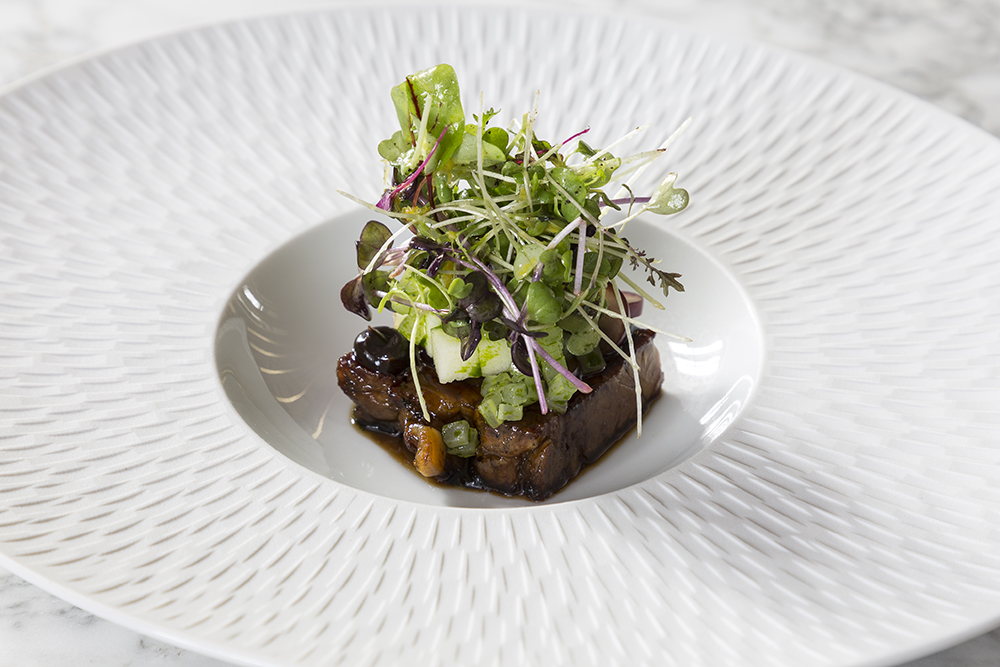
Preheat the oven to 150°C.
Put the goat shoulder in a deep roasting tray. Scatter around the garlic, bay leaves and rosemary, then pour in the water and wine. Season the goat with salt and pepper, then loosely cover the roasting tray with foil. Roast in the oven for 2 hours. Remove the foil and roast for 1 hour more, until the goat is meltingly tender.
Remove the goat shoulder from the tray and press between two large baking sheets weighted down with a few tins of food. Refrigerate for at least 6 hours.
To make the spice mix, warm the mustard seeds in a dry pan over a gentle heat, shaking the pan constantly. The seeds will eventually puff slightly and crack. Once they reach this stage, remove from the heat and grind in a pestle and mortar. Tip back into the warm pan off the heat. Add the fennel seeds and allow them to warm in the residual heat of the pan. In a separate pan, warm the oil slightly with the garlic clove. Take the pan off the heat and add the spices to the oil.
To make the glaze, gently melt together the goat fat or butter and the treacle in a saucepan until combined.
To make the Waldorf salad, put all the ingredients in a bowl and toss gently to combine.
To serve, cut the pressed goat shoulder into neat squares and brush all over with the glaze. Finish the squares on a hot pan until heated through and nicely coloured. Put a square of goat shoulder on a serving plate. Spoon over the spiced oil and season with Maldon flaky sea salt. Finish with a small handful of the Waldorf salad on top.

Dunany Organic Spelt Risotto
Serves 4
- 200g Dunany Organic Spelt Berries
- 25g dried porcini mushrooms
- 1½ tsp olive oil
- 2 shallots, finely chopped
- 2 garlic cloves, finely chopped
- 100ml white wine
- 1 litre hot vegetable stock
- 1 tbsp crème fraîche
- handful of grated Parmesan cheese
- finely snipped fresh chives
- sea salt and freshly ground black pepper
- parsley oil or fresh flat-leaf parsley, finely chopped, to serve
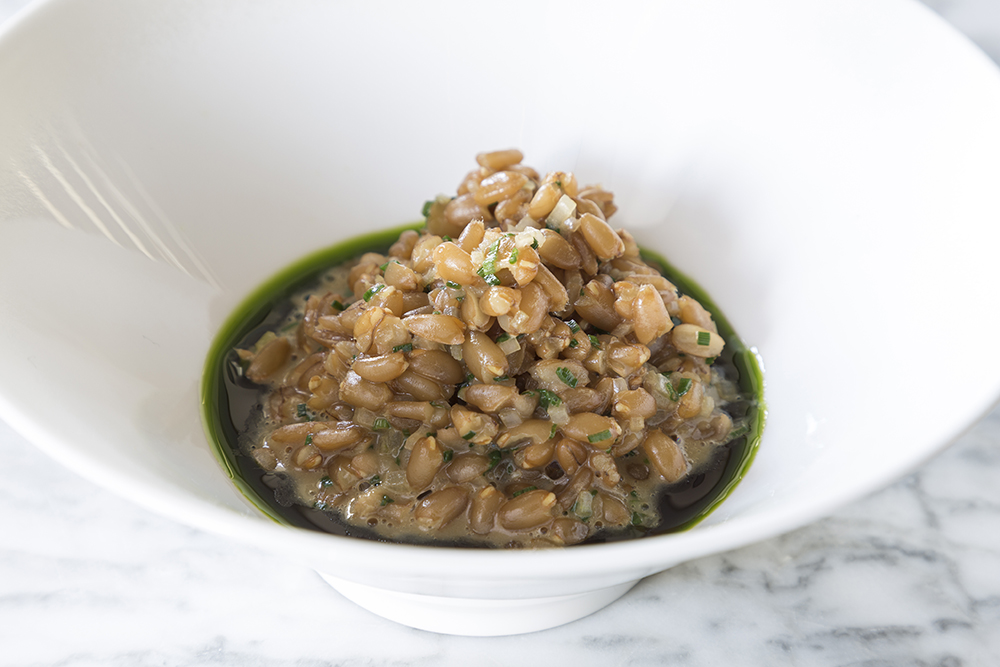
Cover the spelt with cold water. Put the dried mushrooms in a separate heatproof bowl and soak in 100ml of just-boiled water. Allow the spelt and mushrooms to soak for 20 minutes.
Heat the olive oil in a large frying pan over a medium heat. Add the shallots and garlic and cook for 2 minutes. Drain the spelt and add to the pan along with the wine. Simmer until almost all the wine has evaporated, stirring often.
Drain the porcini mushrooms over a bowl so that you can reserve the soaking liquid, then discard the mushrooms. Add the soaking liquid to the vegetable stock. Stir the stock into the spelt berries a ladleful at a time and simmer, stirring often, until all the liquid has been absorbed and the spelt is tender. This will take about 20 minutes in total.
Stir in the crème fraîche, Parmesan and chives, then season to taste with salt and pepper. Divide the risotto between warmed bowls and drizzle over the parsley oil or scatter over some chopped fresh parsley. Serve straight away.

Peter Hannan’s Salt-Aged Glenarm Beef Sirloin with Salt-Baked Celeriac, Hazelnuts and Truffle
Serves 4
- 1kg thick slice of Peter Hannan’s Salt-Aged Glenarm Beef Sirloin
- plenty of sea salt
- soft butter, for cooking
- 100g hazelnuts, toasted and halved, to serve
- Périgord black truffle, for slicing
For the salt-baked celeriac:
- 1 large celeriac
- 700g table salt
- 110g free-range egg whites
- 5 sprigs of fresh rosemary, finely chopped
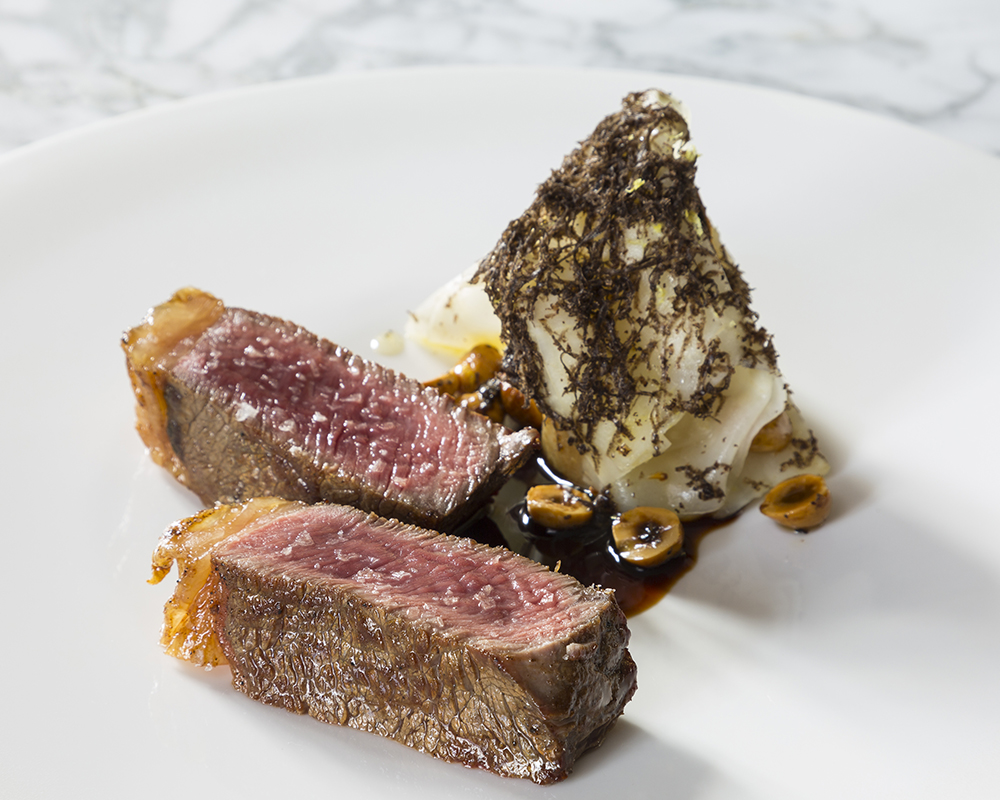
Take the beef out of the fridge and put it on a tray without any covering or cling film. Allow it to sit at room temperature for at least 2 hours before you intend to start working with it so that it has a dry surface and is not too cold when cooked.
Preheat the oven to 190°C.
Place the celeriac in a roasting tray. Mix the table salt, egg whites and rosemary together in a large bowl until the mixture forms a paste. Cover the celeriac in a 2cm-thick layer of the salt paste, ensuring there are no gaps. Bake in the oven for 45 to 50 minutes. Remove from the oven, chip away the salt crust and scoop out the baked celeriac. Portion into nicely sized wedges and reserve until ready to plate.
A little while before you’re ready to start cooking, season the beef with plenty of salt. As it is a very big piece you will need more salt than you think. You will find that if you let the salt dissolve a little, the meat will brown more easily and uniformly.
Melt a large spoon of butter in a large frying pan over a medium-high heat. When the butter has lightly browned, add the beef and cook until the first side is perfectly caramelised. The meat and the pan need to be kept moving at all times so that no part of the pan warms up too much, causing the fat in that part to burn, and so that no part gets too cold and stops the meat from browning.
When the first side is perfect, repeat the process with the second side, adding a little more butter as you turn it. Let the meat rest somewhere warm but not hot, brush with some butter and leave it to rest.
While the meat is resting, pour the butter and fat that have rendered out of the beef through a fine mesh sieve into a container and clean the pan. When the meat is no longer hot to touch, fry it once more in the clean pan, brush it with butter and leave it to rest again. Repeat this process until the meat is cooked to your liking.
To finish the meat, reheat the frying pan and put back the fat strained from the pan earlier. Fry the beef on both sides once more and add some more butter. Let the new butter brown, then immediately lift the meat out and place on a preheated chopping board. Cut it into four strips straight away using a very sharp knife and serve with the salt-baked celeriac, toasted hazelnuts and some shaved truffle.

Killahora Orchards Rare Apple Ice Wine Granita, Sheep’s Yogurt Mousse, Honey and Lime
Serves 4
For the granita:
- 200g caster sugar
- 100ml lemon juice
- 100ml water
- 800g Killahora Orchards Rare Apple Ice Wine
For the sheep’s yogurt mousse:
- 6 gelatine leaves
- 500g sheep’s yogurt
- 130g caster sugar
- 500g cream
To serve:
- Irish honey
- zest of 1 lime
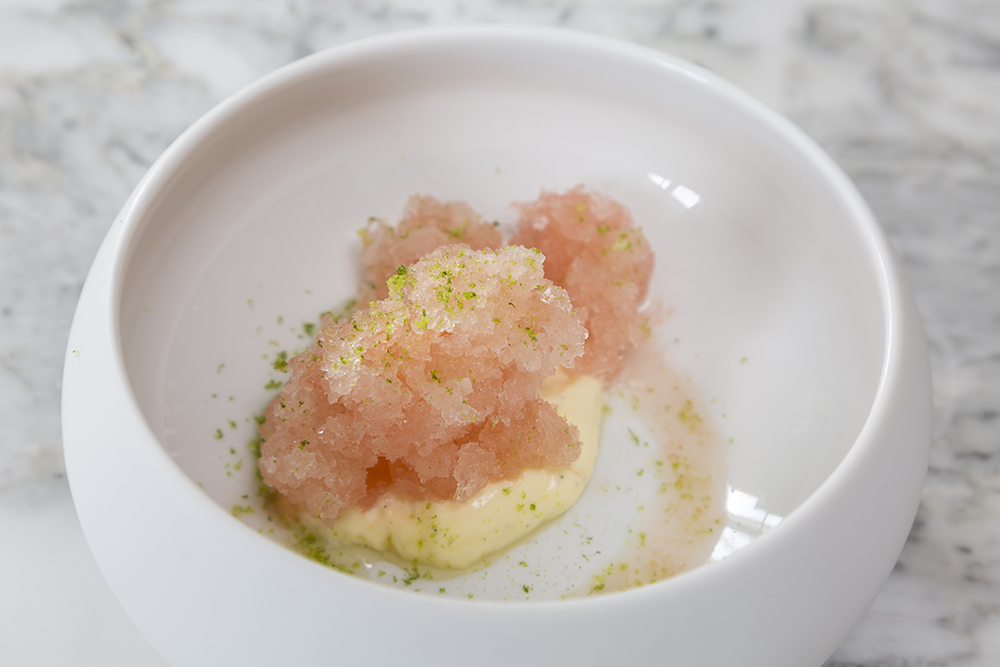
To make the yogurt mousse, bloom the gelatine in a bowl of cold water. In a separate bowl, whisk together the yogurt and sugar. Lightly whip 400g of the cream and boil the remaining 100g of cream (weigh the cream instead of measuring it by volume). Dissolve the gelatine in the boiled cream, then pour onto the yogurt. Fold in the whipped cream and allow to set in the fridge.
To make the granita, place the sugar, lemon juice and water in a pan and heat just until the sugar dissolves. Add the apple ice wine and warm until the mix comes together. Pour into a baking tray or large plastic container. Place in the freezer for about 30 minutes, until it’s becoming icy around the edges. Stir with a fork and place back in the freezer for another 90 minutes, stirring it every 20 or 30 minutes with a fork to scrape the granita into icy crystals, until the granita is completely frozen. This can be made a day ahead and kept tightly covered in the freezer.
To serve, pipe the yogurt mousse into the centre of a serving bowl. Drizzle the honey over the top. Spoon the granita on top and finish with freshly grated lime zest.

3fe Coffee Crémeux with Citrus
Serves 4-6
- 550ml double cream
- 9g ground 3fe coffee
- 1 vanilla pod, halved lengthways and seeds scraped out
- 3½ gelatine leaves, soaked
- 100g caster sugar
- 130g egg yolks (6 or 7 yolks)
- 1 blood orange
- 1 orange
- seeds of 1 pomegranate
- sugar syrup
- zest of 1 lemon
- zest of 1 lime
- cocoa powder, for dusting

Infuse the cream with the coffee and half of the vanilla, then strain through a fine chinois.
Bloom the gelatine in a bowl of cold water.
Whisk the sugar and egg yolks to the ribbon stage. Fold this mixture into the infused cream, then add the soaked gelatine. Pass through a fine mesh sieve, pour into spherical silicone moulds and freeze.
Zest the oranges, then cut them into segments, catching the juice in a bowl. Put the segments in a separate bowl along with the pomegranate seeds. Reduce the juice over a high heat, then stir in a little sugar syrup along with the remaining vanilla and the lemon and lime zest.
To serve, spoon the citrus mixture into the centre of each bowl. Dust each crémeux all over with cocoa powder, then place on top.

Teampall Gael and Young Buck Cheese with Rhubarb and Apple Chutney
For the rhubarb and apple chutney:
- 10 cloves
- 4 star anise
- 3 bay leaves
- 1 cinnamon stick
- 250g rhubarb, chopped
- 250g Bramley apple, peeled, cored and chopped
- 100g Demerara sugar
- 100ml balsamic vinegar
- 100ml water
- zest of 1 orange
Teampall Gael cheese, to serve
Young Buck cheese, to serve
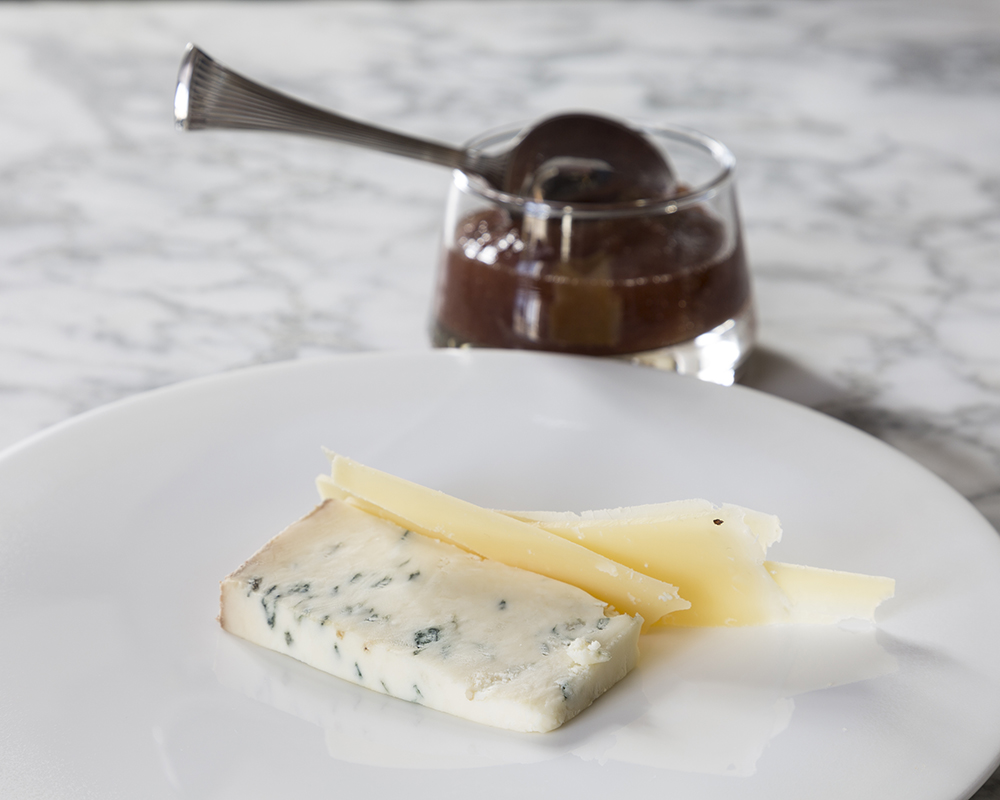
To make the chutney, wrap the cloves, star anise, bay leaves and cinnamon stick in a piece of muslin. Put the rhubarb, apple, sugar, balsamic vinegar, water and the muslin of spices in a pan on a medium heat. Cook until the sugar has dissolved. Increase the heat and cook until thick and syrupy and the rhubarb and apple have softened. Stir in the orange zest and allow to cool.
Serve the Teampall Gael and Young Buck cheese on a cheeseboard with the rhubarb and apple chutney alongside.



